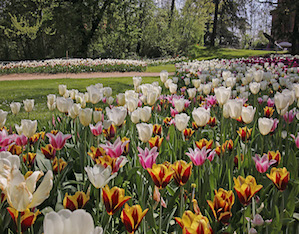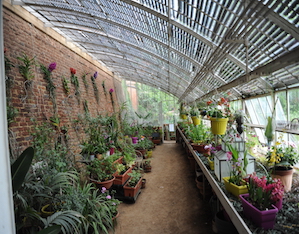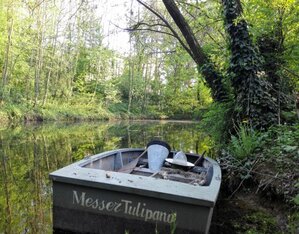Famous for its highly colourful tulip display, the garden of the Castello di Pralormo is interesting all through the year due to its well-designed structure: views through the trees, sunny patches, landscaped greenery blending into the surrounding countryside are all features testifying Kurten’s artistry.
Located on a dominating position at the margins of the Langhe-Roero area, the castle originally dates back to the 13th century. In the 1830s Count Carlo Beraudo di Pralormo, a Minister of the Kingdom of Savoy, initiated the works that radically transformed what was a Medieval fortalice, into the current residence designed by court architect Ernesto Melano. Xavier Kurten, who at the time was working in Racconigi and several other royal and aristocratic residencies across Piedmont, can be credited for the castle’s landscape garden. For the new layout of the park there exists a list compiled by the German architect of nearly 4,000 specimens of exotic and native tree and shrub species that were planted in the winter between 1828 and 1829. Today, centuries-old cedars, oaks, maples, cherry trees, yews, lime trees, lilacs, viburnums, roses, calicanthemums, forsythia, spireas and peonies still give rise to vibrant colour palettes throughout the seasons. Thanks to its limited size and to the fact that it remained property of the same family through the centuries, Castello di Pralormo has preserved its original structure. Minor additions were introduced in the last quarter of the 19th century: the construction of an outbuilding destined to become an orangeryand a stable, the “Castellana” farmstead, and a glass and iron greenhouse designed by the Parisian Lefebvre brothers.
Highlights

“Messer Tulipano”
Since 2000, the park has celebrated the arrival of spring every year with the "Messer Tulipano" exhibition, which features the spectacular flowering of thousands of tulips, narcissus, hyacinths, muscari and crocus, with rare varieties of great historical and botanical significance.

The greenhouse
An important feature of a secluded area of the garden on the southern side of the castle is the late 19th-century iron and glass greenhouse by the Lefebvre Brothers from Paris. Its ideal exposure allows the cultivation of plants such as citrus trees, orchids and other exotic specimen keeping them protected from the rigid Piedmont winters.

The pond
Since the area is rather arid Kurten designed the pond as a rainwater basin for the irrigation of the park. In winter, when the trees are bare, the castle reflects in the crystal-clear water.
 Castello di Pralormo
Contacts
Castello di Pralormo
Contacts
Contacts
Telephone:- +39 348 8626122
- +39 348 8520907
Il parco e il Castello di Pralormo sono aperti alle visite tutte le domeniche dalle 10.00 alle 18.00
Address
Via Umberto I, 26
10040, Pralormo (TO)
 Castello di Pralormo
Opening times and prices
Castello di Pralormo
Opening times and prices
Opening hours
The park and the Castle of Pralormo are open for visits every Sunday from 10.00 to 18.00.
Pricing
Guided tour of the main rooms of the Castle and free visit of the park: -Full price: €9.00 -Reduced groups (minimum 15 people): €8.00 -Reduced discounts: €8.00 -Children aged 4 to 12 and disabled people: €5.00 -free for children up to 4 years old and those accompanying disabled people
 Castello di Pralormo
How to get there
Castello di Pralormo
How to get there
Address
Via Umberto I, 26
10040, Pralormo (TO)
Latitude: 44.8624268
Longitude: 7.9002233
How to arrive by road
From Turin
- Motorway A21 TORINO-PIACENZA, exit SANTENA. Then follow the signs for ALBA-POIRINO.
- Motorway A21 PIACENZA TORINO, exit VILLANOVA D’ASTI. Then follow the signs for ALBA-POIRINO
- A6 TORINO-SAVONA motorway, CARMAGNOLA exit. Then follow the signs for PRALORMO
From Milan
- Motorway A7 MILANO-GENOVA, take the A6 PIACENZA-TORINO. Exit VILLANOVA D’ASTI. Then follow the signs for ALBA-POIRINO.
- MILAN-TORINO motorway, TURIN ring road, follow signs for the A6 TORINO-SAVONA motorway, CARMAGNOLA exit, follow signs for PRALORMO.
How to arrive by bus
 Castello di Pralormo
Services/Accessibility
Castello di Pralormo
Services/Accessibility
Services
The Castle of Pralormo offers the possibility of staying in the "Case della Giardiniera" (Gardener's Houses) located along the castle wall. For more information on costs and bookings consult the website.
The Castle of Pralormo offers the possibility of staying in the "Case della Giardiniera" (Gardener's Houses) located along the castle wall. For more information on costs and bookings consult the website.
The Castle of Pralormo offers the possibility of staying in the "Case della Giardiniera" (Gardener's Houses) located along the castle wall. For more information on costs and bookings consult the website.
The Castle of Pralormo offers the possibility of staying in the "Case della Giardiniera" (Gardener's Houses) located along the castle wall. For more information on costs and bookings consult the website.
Visitors can stop and eat a picnic, if they have brought it from home, in the grassy areas indicated by the signs or in a large porch of the Castellana farmhouse where there are tables and benches.
Visitors can stop and eat a picnic, if they have brought it from home, in the grassy areas indicated by the signs or in a large porch of the Castellana farmhouse where there are tables and benches.
Visitors can stop and eat a picnic, if they have brought it from home, in the grassy areas indicated by the signs or in a large porch of the Castellana farmhouse where there are tables and benches.
Visitors can stop and eat a picnic, if they have brought it from home, in the grassy areas indicated by the signs or in a large porch of the Castellana farmhouse where there are tables and benches.
Dogs are allowed in the park.
It is possible to organize guided tours or participate in the educational activities offered by the structure. For further information please consult the website.
The facility has a bookshop for purchases.
- Visits to the Park alone do not require a reservation, but access is restricted and regulated by the staff at the cash desk according to the number of visitors.
- For the visit of the Castle and the Park, booking is recommended. The tour in the building takes place every half hour, lasts about 45 minutes, with a guide and in groups of maximum 15 people.
Accessibility
- Activities and services are accessible to disabled people
- The interior of the castle is difficult to access.
 Castello di Pralormo
Private events
Castello di Pralormo
Private events
The Castle of Pralormo offers the possibility to organize many private events such as receptions, weddings and conferences. Receptions at Pralormo Castle take place in the Orangerie, in the ancient French greenhouse and in La Castellana, the farmhouse with its grand stables.
 Castello di Pralormo
Itineraries
Castello di Pralormo
Itineraries
 Favorite saving result
Favorite saving result
 Warning!
Warning!
You've have to sign up or sign in to add this element to your favorites.
